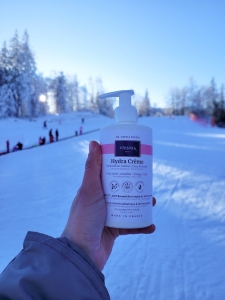Leestijd: mins
The world of cosmetics is as vast as it is diverse, offering an infinite number of options for caring for our appearance and well-being. However, this abundance has its downside. The presence of potentially harmful chemical substances, in particular CMR substances, in certain cosmetic products is a major public health issue. European regulations play a crucial role in ensuring that these substances are rigorously assessed and controlled to maintain consumer safety. Understanding the regulatory framework and the implications of CMR substances therefore becomes essential to making informed, safe choices.
The attention paid to the components of cosmetic products has increased considerably in recent years, driven by debates on health and the environment. Consumers are increasingly informed and demanding about the composition of the products they use every day. This trend highlights the crucial importance of legislation and regulation in this sector. Because of their potentially hazardous nature, CMR substances are the focus of much concern, prompting industry and legislators to adopt strict measures to limit exposure.
The regulation of CMR substances is not limited to prohibiting their use. It also includes a rigorous scientific evaluation framework, aimed at understanding and quantifying their potential impact on health. This approach ensures that only products meeting strict safety standards reach consumers’ hands. Transparency and education also play a major role, enabling people to make informed choices about the products they apply to their skin.
The term ‘CMR substances’ refers to a specific category of chemical substances identified for their carcinogenic, mutagenic or reprotoxic potential. This classification is based on rigorous scientific criteria and in-depth epidemiological studies. The aim is to protect individuals and the environment from the harmful effects these substances can cause, whether through long-term exposure or at specific doses.
The regulation of CMR substances is essential to protect public health. Around the world, regulatory authorities are making considerable efforts to identify, assess and control the use of CMR substances in a variety of products, including but not limited to cosmetics. These regulations are based on a preventive approach, aimed at limiting consumer exposure to these potentially dangerous substances as far as possible. It reflects a collective awareness of the importance of consumer product safety and the societal responsibility incumbent on manufacturers.
Europe stands out for its particularly strict regulatory framework for CMR substances. Regulation No. 1223/2009 of the European Parliament and of the Council is a key text governing the use of these substances in cosmetic products. This regulation illustrates Europe’s commitment to guaranteeing high safety standards for consumers. In addition to bans and restrictions, this framework includes provisions for scientific evaluation, labeling and risk communication, ensuring optimum protection while encouraging innovation and the development of safe, effective products.
European regulations on cosmetics are recognized for their high level of consumer protection. Regulation No. 1223/2009 is the cornerstone of this policy, laying down strict requirements for the marketing of cosmetic products. This legislation aims not only to limit the use of CMR substances, but also to promote a culture of safety and innovation within the European cosmetics industry. By imposing rigorous standards for product safety assessment and traceability, the EU is setting an example in terms of protecting the health and well-being of consumers.
Although the use of CMR substances in cosmetic products is generally restricted, the regulation provides for certain exemptions under strict conditions. These exceptions are based on thorough scientific assessments demonstrating that the use of the substance in question does not present a risk to human health under the specified conditions of use. This legislative flexibility is crucial to enable innovation and the development of new products, while ensuring a high level of safety for consumers.
In addition to the regulation of CMR substances, the EU attaches particular importance to the protection of workers in the cosmetics industry. Preventive measures, including training and information, are put in place to minimize the risk of occupational exposure. These initiatives underline the EU’s holistic approach to cosmetics safety, focusing on the protection of all those involved in their production and marketing.
The regulation of CMR substances in the cosmetics industry is testimony to the European authorities’ commitment to consumer protection. By adopting a proactive approach and promoting transparency, the EU is helping to raise standards of safety and innovation in the sector. For consumers, turning to responsible brands like Vernixa, committed to using safe, natural ingredients, represents a step towards more responsible consumption and healthy living. Choosing consciously is a gesture of well-being for yourself and for the environment.
Discovering the safe, effective alternatives offered by Vernixa paves the way for a respectful, responsible beauty routine. To find out more about their commitments and products for everyone, visit the Vernixa website.
Alle rechten voorbehouden GTIN-naleving Hydra Lavant | GTIN Naleving Hydra Crème



